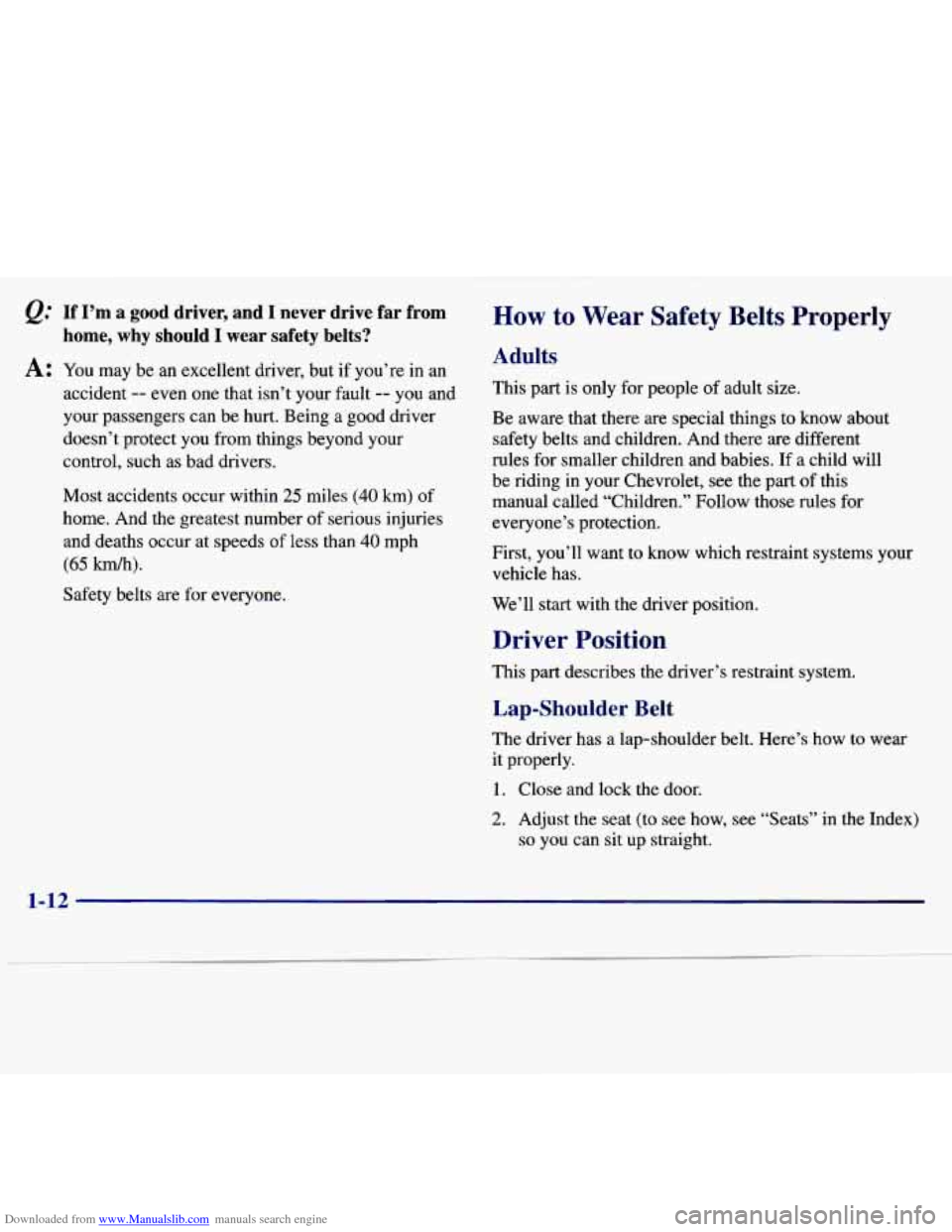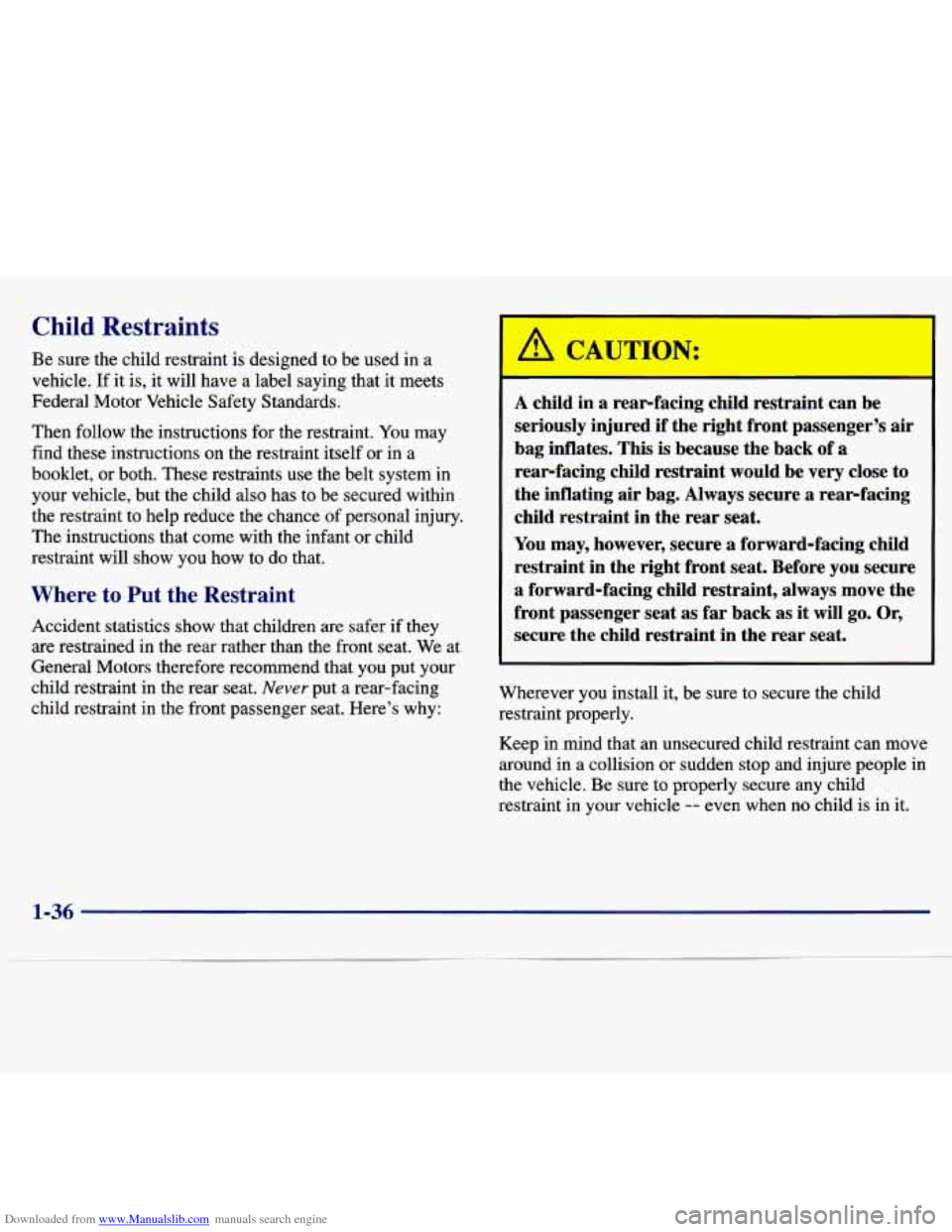Page 10 of 354
Downloaded from www.Manualslib.com manuals search engine Section 1 Seats and Seat Restraints
Here you’ll find information about the seats in your Chevrol\
et and how to use your safety belts properly. You can also
learn about some things you should
not do with air bags and safety belts.
1-2
1-2
1-3
1-4
1-5
1-8 1-11
1-12 1-15 Seats and Controls
Manual Seats
Power Seats
Reclining Front Seatbacks
Rear Seats
Why Safety Belts Work
Questions Many People Ask About
Safety Belts
How to Wear Safety Belts Properly
Shoulder Belt Height Adjuster 1-20
1-23
1-30
1-34
1-36
1-37
1-47
1-47 1-47 Safety Belt Use During Pregnancy
Questions and Answers About Air Bags Safety Belt Comfort Guides
How to Use Child Restraints
Important Information for Buckling Children in Child Restraints
Child Restraint Top Straps
How to Obtain a Safety Belt Extender
Checking Your Restraint Systems
Replacing Parts After a Crash
1-1
-----
Page 21 of 354

Downloaded from www.Manualslib.com manuals search engine @ If I’m a good driver, and I never drive far from
A: You may be an excellent driver, but if you’re in an
home, why should I wear safety belts?
accident -- even one that isn’t your fault -- you and
your passengers can be hurt. Being a good driver
doesn’t protect you from things beyond your
control, such as bad drivers.
Most accidents occur within
25 miles (40 km) of
home. And the greatest number
of serious injuries
and deaths occur at speeds of less than
40 mph
(65 km/h).
Safety belts are for everyone.
H,,, to Wear Safety Belts Properly
Adults
This part is only for people of adult size.
Be aware that there are special things to know about safety belts and children. And there are different
rules for smaller children and babies. If
a child will
be riding in your Chevrolet, see the part of this
manual called “Children.” Follow those rules for
everyone’s protection.
First, you’ll want to know which restraint systems your vehicle has.
We’ll start with the driver position.
Driver Position
This part describes the driver’s restraint system.
Lap-Shoulder Belt
The driver has a lap-shoulder belt. Here’s how to wear
it properly.
1. Close and lock the door.
2. Adjust the seat (to see how, see “Seats” in the Index)
so you can sit up straight.
1-12
Page 40 of 354
Downloaded from www.Manualslib.com manuals search engine There is one guide for each outside passenger position in
the rear seat. To provide added safety belt comfort for
children who have outgrown child restraints and for
smaller adults, the comfort guides may be installed on
the shoulder belts. Here’s how to install a comfort guide
and use the safety belt:
2. Slide the guide under and past the belt. The elastic
cord must be under the belt. Then, place the guide
over the belt, and insert the two edges
of the belt into
the slots of the guide.
1. Pull the elastic cord out from between the edge of
the seatback and the interior body to remove the
guide from its storage clip.
1-31
Page 45 of 354

Downloaded from www.Manualslib.com manuals search engine Child Restraints r
Be sure the child restraint is designed to be used in a
vehicle.
If it is, it will have a label saying that it meets
Federal Motor Vehicle Safety Standards.
Then follow the instructions for the restraint.
You may
find these instructions
on the restraint itself or in a
booklet,
or both. These restraints use the belt system in
your vehicle, but the child also has to be secured within
the restraint to help reduce the chance of personal injury.
The instructions that come with the infant or child
restraint will show you how to do that.
Where to Put the Restraint
Accident statistics show that children are safer if they
are restrained in the rear rather than the front seat. We at
General Motors therefore recommend that you put your
child restraint in the rear seat.
Never put a rear-facing
child restraint in the front passenger seat. Here’s why:
A child in a rear-facing child restraint can be
seriously injured if the right front passenger’s air
bag inflates. This is because the back of a
rearfacing child restraint would be very close to
the inflating air bag. Always secure a rear-facing
child restraint in the rear seat.
You may, however, secure a forward-facing child
restraint in the right front seat. Before you secure
a forward-facing child restraint, always move the
front passenger seat as far back as
it will go. Or,
secure the child restraint in the rear seat.
Wherever you install it, be sure to secure the child
restraint properly.
Keep in mind that an unsecured child restraint
can move
around in a collision or sudden stop and injure people in
the vehicle. Be sure to properly secure
any child
restraint in your vehicle
-- even when no child is in it.
1-36
Page 47 of 354
Downloaded from www.Manualslib.com manuals search engine Securing a Child Restraint in a Rear Outside Seat Position
l You’ll be using the lap-shoulder belt. See the earlier part
about the top strap if the child restraint has one.
1. Put the restraint on the seat. Follow the instructions
for the child restraint.
2. Secure the child in the child restraint as the
instructions say.
3. Pick up the latch plate, and run the lap and shoulder
portions of the vehicle’s safety belt through or
around the restraint. The child restraint instructions
will show you how. Tilt the latch plate to adjust the belt
if needed. If the shoulder belt goes in front of the child’s face or
neck, put it behind the child restraint.
1-38
Page 49 of 354
Downloaded from www.Manualslib.com manuals search engine Securing a Child Restraint in the Center
Rear Seat Position
U
You’ll be using the lap belt.
See the earlier part about the top strap if the child
restraint has one.
1.
2.
3.
4.
Make the belt as long as possible by tilting the latch
plate and pulling it along the belt.
Put the restraint on the seat.
Follow the instructions
for the child restraint.
Secure the child in the child restraint as the
instructions say.
Run the vehicle’s safety belt through or around the
restraint. The child restraint instructions will show
you how.
1-40
Page 51 of 354

Downloaded from www.Manualslib.com manuals search engine Securing a Child Restraint in the Right
Front Seat Position
Pour vehicle has a right front passenger air bag. Never
put a rear-facing child restraint in this seat. Here’s why:
PL CAUTION:
A child in a rear-facing child restraint can be
seriously injured if the right front passenger’s air
bag inflates. This is because the back of a rearfacing child restraint would be very close to
the inflating air bag. Always secure
a rearfacing
child restraint in the rear seat.
You’ll be using the lap-shoulder belt. See the earlier part
about the top strap if the child restraint has one.
1. Because your vehicle has a right front passenger air
bag, always move the seat as far back as it will go
before securing a forward-facing child restraint. (See
“Seats” in the Index.)
2. Put the restraint on the seat. Follow the instructions
for the child restraint.
3. Secure the child in the child restraint as the
instructions say.
4. Pick up the latch plate, and run the lap and shoulder
portions of the vehicle’s safety belt through or
around the restraint. The child restraint instructions
will show you how.
1-42
Page 54 of 354

Downloaded from www.Manualslib.com manuals search engine Accident statistics show that children are safer if they
are restrained in the rear seat. But they need to use the
safety belts properly.
Children who aren’t buckled up can be thrown out in
Children who aren’t buckled up can strike other
a crash.
people who are.
Never do this.
Here two children are wearing the same belt. The
belt can’t properly spread the impact forces.
In a
crash, the two children can be crushed together
and seriously injured.
A belt must be used by
only one person at a time.
What if
a child is wearing a lap-shoulder belt,
but the child
is so small that the shoulder belt is
very close to the child’s face or neck?
A: Move the child toward the center of the vehicle, but
be sure that the shoulder belt still is
on the child’s
shoulder,
so that in a crash the child’s upper body
would have the restraint that belts provide.
If the
child is sitting in a rear seat outside position, see “Rear Safety Belt
Comfort Guides’’ in the Index. If
the child
is so small that the shoulder belt is still
very close to the child’s face or neck, you might
want to place the child in the center seat position,
the one that has only a lap belt.
1-45